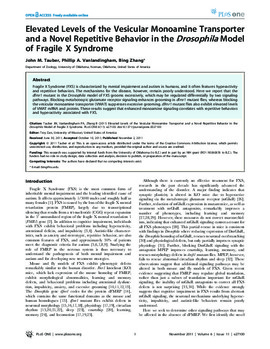| dc.contributor.author | John M. Tauber | en_US |
| dc.contributor.author | Phillip A. Vanlandingham | en_US |
| dc.contributor.author | Bing Zhang | en_US |
| dc.date.accessioned | 2015-01-23T17:17:33Z | |
| dc.date.accessioned | 2016-03-30T15:35:45Z | |
| dc.date.available | 2015-01-23T17:17:33Z | |
| dc.date.available | 2016-03-30T15:35:45Z | |
| dc.date.issued | 2011-11-02 | en_US |
| dc.identifier.citation | Tauber JM, Vanlandingham PA, Zhang B (2011) Elevated Levels of the Vesicular Monoamine Transporter and a Novel Repetitive Behavior in the Drosophila Model of Fragile X Syndrome. PLoS ONE 6(11): e27100. doi:10.1371/journal.pone.0027100 | en_US |
| dc.identifier.uri | https://hdl.handle.net/11244/14070 | |
| dc.description | We thank Drs. Yong Q. Zhang and Kendal Broadie for providing the w; dfmr183M/TM6B, Tb stock, and Dr. Thomas Jongens for providing the w; dfmr13/TM6C, Sb, wild-type rescue (Control) and frameshift rescue (FS) stocks. We also thank Dr. David Krantz for his advice on the use of acetic acid in dissolving reserpine and for providing the antibody to dVMAT, Drs. Michael Tranfaglia, Randy Hewes, Rosemary Knapp, and David McCauley for constructive comments on the manuscript, Dr. Lauren Ritterhouse for assistance in the statistical analysis of the data, Logan Cox for assistance on fly husbandry, and Emily Kumimoto, Rod Kumimoto, and Sunetra Das for their instruction and assistance with RNA isolation and real-time PCR. The MPEP drug was a generous gift of Dr. Michael Tranfaglia from the FRAXA Research Foundation. J.M.T. received the inaugural Vad Foundation Award for Outstanding Undergraduate Thesis for this research. We wish to thank Dr. Vijay Vad and his Foundation for his support. | en_US |
| dc.description | Conceived and designed the experiments: JMT BZ. Performed the experiments: JMT PAV. Analyzed the data: JMT PAV BZ. Contributed reagents/materials/analysis tools: JMT PAV BZ. Wrote the paper: JMT BZ. Edited the text: PAV. | en_US |
| dc.description.abstract | Fragile X Syndrome (FXS) is characterized by mental impairment and autism in humans, and it often features hyperactivity and repetitive behaviors. The mechanisms for the disease, however, remain poorly understood. Here we report that the dfmr1 mutant in the Drosophila model of FXS grooms excessively, which may be regulated differentially by two signaling pathways. Blocking metabotropic glutamate receptor signaling enhances grooming in dfmr1 mutant flies, whereas blocking the vesicular monoamine transporter (VMAT) suppresses excessive grooming. dfmr1 mutant flies also exhibit elevated levels of VMAT mRNA and protein. These results suggest that enhanced monoamine signaling correlates with repetitive behaviors and hyperactivity associated with FXS. | en_US |
| dc.language.iso | en_US | en_US |
| dc.publisher | PLos One | en_US |
| dc.relation.ispartofseries | PLoS ONE 6(11):e27100 | en_US |
| dc.relation.uri | http://www.plosone.org/article/info%3Adoi%2F10.1371%2Fjournal.pone.0027100 | en_US |
| dc.rights | Attribution 3.0 United States | en_US |
| dc.rights.uri | https://creativecommons.org/licenses/by/3.0/us/ | en_US |
| dc.subject | PLOS | en_US |
| dc.subject | Public Library of Science | en_US |
| dc.subject | Open Access | en_US |
| dc.subject | Open-Access | en_US |
| dc.subject | Science | en_US |
| dc.subject | Medicine | en_US |
| dc.subject | Biology | en_US |
| dc.subject | Research | en_US |
| dc.subject | Peer-review | en_US |
| dc.subject | Inclusive | en_US |
| dc.subject | Interdisciplinary | en_US |
| dc.subject | Ante-disciplinary | en_US |
| dc.subject | Physics | en_US |
| dc.subject | Chemistry | en_US |
| dc.subject | Engineering | en_US |
| dc.title | Elevated Levels of the Vesicular Monoamine Transporter and a Novel Repetitive Behavior in the Drosophila Model of Fragile X Syndrome | en_US |
| dc.type | Research Article | en_US |
| dc.description.peerreview | Yes | en_US |
| dc.description.peerreviewnotes | http://www.plosone.org/static/editorial#peer | en_US |
| dc.identifier.doi | 10.1371/journal.pone.0027100 | en_US |
| dc.rights.requestable | false | en_US |

